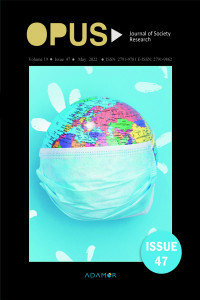Level of Knowledge and Awareness of Pregnant Women about the Coronavirus Pandemic (COVID-19): An Assessment from a Developing Country
Pregnant women may experience psychological difficulties during the pregnancy experience. Being pregnant during the Covid-19 pandemic process carries pregnancy experiences to a different dimension. Pregnancy is among the vulnerable groups against respiratory tract infections. Health systems support services should be provided to women of reproductive age and pregnant women during the COVID-19 pandemic. This study aims to determine the information needs of pregnant women during the COVID-19 epidemic and to contribute to increasing the quality of health care services to be provided.The sample of this study consisted of 254 pregnant from Trakya University Medical Faculty Obstetrics Clinic in Turkey. The study was conducted from December 2019 to October 2021. Two scales were used in our study. Participants were first evaluated with a personal information form. The scales we used in our study, Perceived Stress Scale-10 (PSS-10), Beck Anxiety Inventory (BAI) were used.In our study; concerns of pregnant women for their own health, their unborn baby (children) and the postpartum period were significantly higher during the COVID-19 pandemic. In addition, the COVID-19 pandemic has demonstrated the need for optimal community use of maternal and child health services. As the time of birth approached, the feeling of pregnant women was increasing.Developing countries may be the weakest part of the chain to stop the spread of current and future epidemics.It is necessary to carry out a well-planned, high-quality and structured training program in order to increase the level of social awareness and contribute to better process management in pregnant women.
Keywords:
Developing Country, Pregnancy, The Perceived Stress Scale Coronovirus Pandemic (COVID-19),
___
- Al-Ahdal, M. N., Al-Qahtani, A. A., & Rubino, S. (2012). Coronavirus respiratory illness in Saudi Arabia. The Journal of infection in developing countries, 6(10), 692-694.
- Beck, A. T., Epstein, N., Brown, G., & Steer, R. A. (1988). An inventory for measuring clinical anxiety: Psychometric properties. Journal of consulting and clinical psychology, 56(6), 893.
- Cohen, S., Kamarck, T., & Mermelstein, R. (1983). A global measure of perceived stress. Journal of health and social behavior, 24(1), 385-396.
- Eskin, M., Harlak, H., Demirkıran, F., & Dereboy, Ç. (2013). Algılanan stres ölçeğinin Türkçeye uyarlanması: güvenirlik ve geçerlik analizi. New Symposium Journal, 51(3), 132-140.
- Gur, R. E., White, L. K., Waller, R., Barzilay, R., Moore, T. M., Kornfield, S., . . . Parish-Morris, J. (2020). The disproportionate burden of the COVID-19 pandemic among pregnant black women. Psychiatry research, 293, 113475.
- Ihlen, Ø., & Fredriksson, M. (Eds.). (2009). Public relations and social theory: Key figures and concepts (1st ed.). Routledge. https://doi.org/10.4324/9780203883235
- Kelvin, D. J., & Rubino, S. (2020). Fear of the novel coronavirus. The Journal of infection in developing countries, 14(01), 1-2.
- Lebel, C., MacKinnon, A., Bagshawe, M., Tomfohr-Madsen, L., & Giesbrecht, G. (2020). Elevated depression and anxiety symptoms among pregnant individuals during the COVID-19 pandemic. Journal of affective disorders, 277, 5-13.
- Lu, W., Bian, Q., Wang, W., Wu, X., Wang, Z., & Zhao, M. (2017a). Chinese version of the Perceived Stress Scale-10: A psychometric study in Chinese university students. PloS one, 12(12), e0189543.
- Lu, W., Bian, Q., Wang, W., Wu, X., Wang, Z., & Zhao, M. (2017b). Chinese version of the Perceived Stress Scale-10: A psychometric study in Chinese university students. PloS one, 12(12), e0189543.
- Naurin, E., Markstedt, E., Stolle, D., Enström, D., Wallin, A., Andreasson, I., . . . Elden, H. (2021). Pregnant under the pressure of a pandemic: A large-scale longitudinal survey before and during the COVID-19 outbreak. European journal of public health, 31(1), 7-13.
- Porcheddu, R., Serra, C., Kelvin, D., Kelvin, N., & Rubino, S. (2020). Similarity in case fatality rates (CFR) of COVID-19/SARS-COV-2 in Italy and China. The Journal of infection in developing countries, 14(02), 125-128.
- Qiao, J. (2020). What are the risks of COVID-19 infection in pregnant women? The Lancet, 395(10226), 760-762.
- Ravaldi, C., Wilson, A., Ricca, V., Homer, C., & Vannacci, A. (2021). Pregnant women voice their concerns and birth expectations during the COVID-19 pandemic in Italy. Women and Birth, 34(4), 335-343.
- Wongpakaran, N.,& Wongpakaran, T. (2010). The Thai version of the PSS-10: An investigation of its psychometric properties. BioPsychoSocial medicine, 4(1), 6.
- Zhong, N., Zheng, B., Li, Y., Poon, L., Xie, Z., Chan, K., . . . Xie, J. (2003). Epidemiology and cause of severe acute respiratory syndrome (SARS) in Guangdong, People's Republic of China, in February, 2003. The Lancet, 362(9393), 1353-1358.
- Zhu, N., Zhang, D., Wang, W., Li, X., Yang, B., Song, J., . . . Lu, R. (2020). A novel coronavirus from patients with pneumonia in China, 2019. New England Journal of Medicine, 382, 727-733.
- Yayın Aralığı: Yılda 6 Sayı
- Başlangıç: 2011
- Yayıncı: ADAMOR Toplum Araştırmaları Merkezi
Sayıdaki Diğer Makaleler
Didem ÖNAY DERİN, Bedia YILDIRIM
Assessment of Antoni Gaudi's Design Approach on the Concept of Biophilia: Case of Casa Battlo
Users' Emotional Experiences in Online Shopping: Effects of Design Components
Ersin KARAMAN, Nurcan ALKIŞ BAYHAN, Esra ÖZMEN
Esra ÖZMEN, Ersin KARAMAN, Nurcan ALKIŞ BAYHAN
